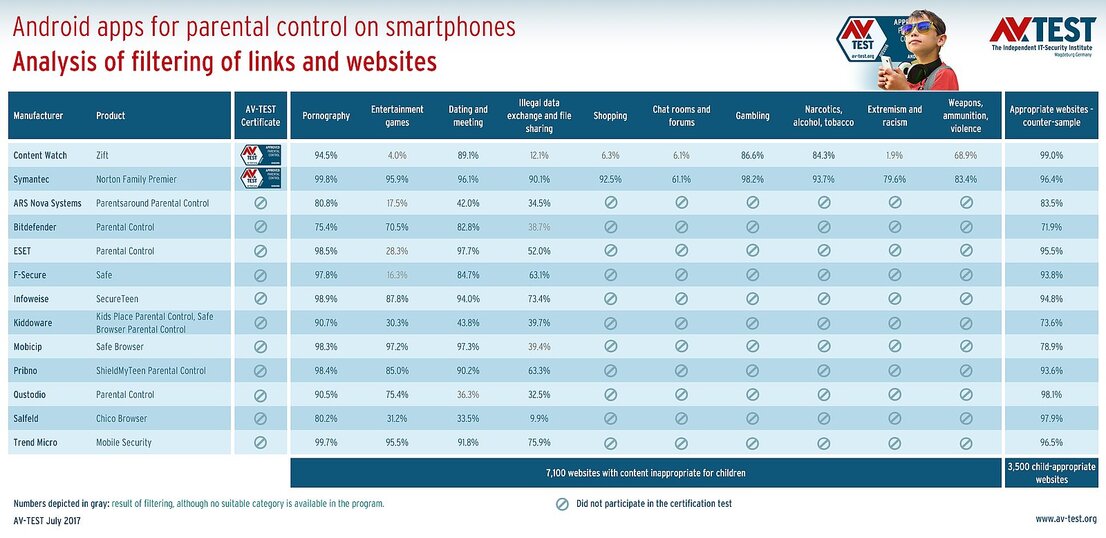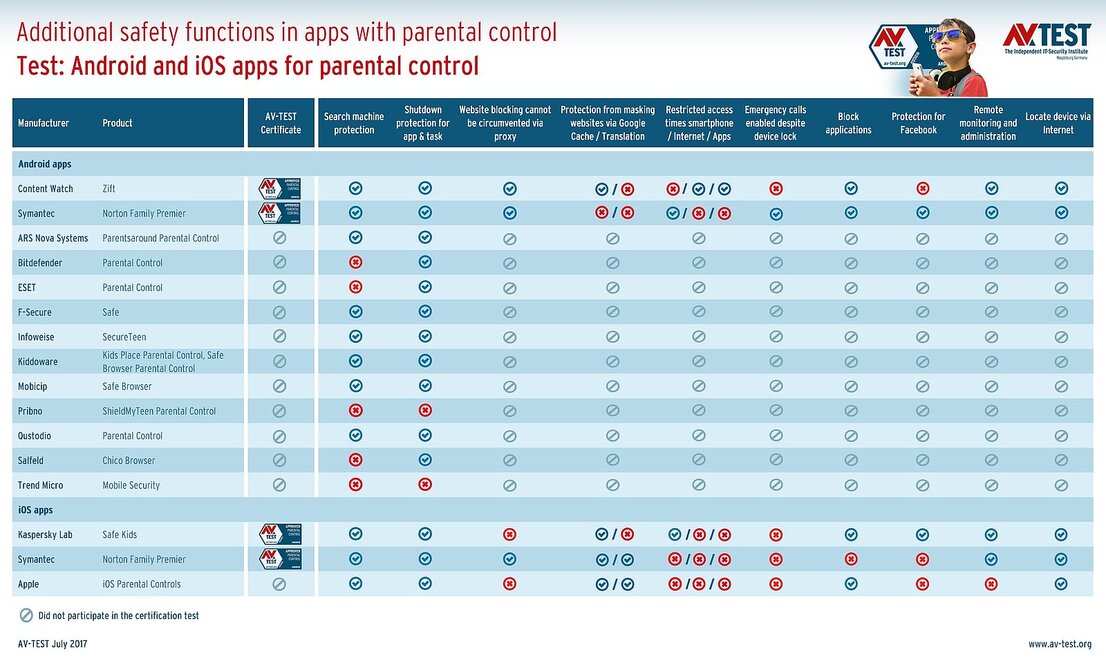Latest News
August 28, 2017 | Parental control
16 Parental Control Apps for Android & Apple iOS
Many parents consider it completely normal to regulate their children's access to the Internet via a PC. It is astounding that this is not the case with smart phone use: Children normally have full access to the Internet, usually all day long – with all benefits and risks. Parental control apps can provide help in this regard. AV-TEST tested, evaluated, and partly gave awards to 16 protection options for Android devices and Apple iOS.
What are the features that every parental control app needs to have? If you ask parents, they often only shrug their shoulders at this question. Because parents normally do not know the technical possibilities and therefore have no concept as to what makes a well-equipped app. At the least, a parental control app needs to be reliable and to prohibit access to unsuitable content. These key criteria, along with other features, were covered in the testing of digital protection apps. In the test, 13 apps for Android devices and three mini programs for Apple iOS were put to the test, whereby the internal protection functions of Apple iOS also count as an app.

Filter test for parental control apps
Some of the apps achieve very high scores in filtering unsuitable websites, while still allowing access to normal websites.

Other security features
The Parental Control apps generally cannot be shut down or stopped via the task manager.

Reporting and log functions
The apps record very many of the events on a mobile device – especially the browsing habits.

Symantec Norton Family Premier
The child can read what the parents have blocked and what they monitor with the help of the app.

Content Watch Zift
Device location and time restriction of Internet access are two popular features among parents.
Website filters and other protection measures
The thrust of the test naturally focused on filtering Internet content. A parental control app is supposed to block anything unsuitable for children. By contrast, websites that are suitable should not be blocked by mistake. Moreover, the additional protection functions were evaluated with which an app also protect itself against children with extremely adept technical skills – i.e. the issue of whether an app can be defeated or simply shut down. However, the test also included functions such as location of a device, protection for Facebook or possible time restrictions for the Internet.
In the last test segment, the testers rated the reporting functions of the apps. This included, for example, whether they stored a browsing history of the websites, recorded prohibited access or noted requested and blocked Internet addresses. Because many parents also want to know whether the protection works effectively and what their little angels are up to on the Internet.
For comparison, each profile offered in the apps for seven-year-old children was selected. The parental control apps mostly offer three or four pre-configured profiles.
The 16 test candidates at a glance
The test encompassed 13 apps for Android, two apps for iOS and the built-in parental control app of iOS. The Android protectors Norton Family Premier from Symantec and Zift from Content Watch submitted to a comprehensive certification test. That is why they were required to successfully complete many more tests and filtering routines than the other apps.
In the area of iOS, the apps Safe Kids from Kaspersky Lab and Norton Family Premier from Symantec underwent the certification test. The scores of the internal protection app from iOS provided a comparison.
Apps for Android
- ARS Nova Systems, Parentsaround Parental Control
- Bitdefender, Parental Control
- Content Watch, Zift
- ESET, Parental Control
- F-Secure, Safe
- Infoweise, SecureTeen
- Kiddoware, Kids Place Parental Control, Safe Browser Parental Control
- Mobicip, Safe Browser
- Pribno, ShieldMyTeen Parental Control
- Qustodio, Parental Control
- Salfeld, Chico Browser
- Symantec, Norton Family Premier
- Trend Micro, Mobile Security
Apps for Apple iOS
- Kaspersky Lab, Safe Kids
- Symantec, Norton Family Premier
- Apple, iOS Parental Controls (internal)
Over 10,000 websites in the filter test
In the test, all the apps were required to filter out over 7,100 websites with unsuitable content, followed by 3,500 websites with suitable content. In this test, a good app ought to block as many unsuitable websites as possible, yet leave the appropriate websites alone. It is a difficult task, because if the filtered technologies are too aggressive, many normal websites will also be blocked. This makes for an annoyed child and overwhelms the parents with questions as to why a certain website doesn't work. This needs to be prevented.
The filtering test, however, only works on the Android test platform. Apple's iOS it is designed so restrictively that the test is not technically possible. The filtering does work, but the system does not provide any data for evaluation.
The apps were required to filter the websites from the following categories:
- Pornography
- Entertainment games
- Dating and meeting
- Illegal data exchange and file sharing
Additional categories for the certification test:
- Shopping websites
- Chat rooms and forums
- Gambling
- Narcotics, alcohol, tobacco
- Extremism and racism
- Weapons, ammunition, violence
On all apps that did not participate in the certification test, the three following categories were tested for direct comparison, in addition to pornography: entertainment games, dating and meeting as well as illegal data exchange and file sharing. These were important to the testers for the following reason: Games offer children the internal option of purchasing expensive accessory equipment. For dating and meeting sites, children risk entering into online romances with disguised pedophile adults. In the area of filesharing, parents may incur liability for their children, which can be expensive.
In the category of pornography alone, each app was required to filter out 1,400 websites. In this area, a large number of programs showed robust filtering capabilities in this category. The apps from Symantec and Trend Micro demonstrated the greatest level of sensitivity. They filtered 99.8 and 99.7% respectively of the websites with pornography, yet still allowed 96.4 and 96.5% respectively of the suitable websites.
The special parental control apps from Kiddoware and Mobicip did indeed achieve high blocking rates, but only because they blocked too many – also well over 20% of the suitable websites.
More categories for comparing the apps
The additional categories of entertainment games, dating and meeting, as well as illegal data exchanges and file sharing, were evaluated for comparison of all the apps. Some of the test score results are somewhat poor, despite existing filter categories. The apps from ARS Nova Systems, Kiddoware and Salfeld only filtered between 9.9 up to 44 percent of the websites. The scores of Qustodio are also too low. Other tools partly lacked the categories. That is why those test scores are depicted in gray type in the table.
Additional parental control functions in the apps
Partners in the filtering of websites include the search engines such as Google etc. That is why in many parental control apps, the safe-search function can be activated as search engine protection for the browser. Search engines that do not offer safe-search functions thus cannot be used. These Android apps offer the protection function: ARS Nova Systems, Content Watch, F-Secure, Infoweise, Kiddoware, Mobicip, Qustodio and Symantec. All iOS apps tested also include the function in the package.
In addition, the test examined whether the apps could be defeated or even offer shutdown protection. This feature was included in all Android tools except the products from Pribno and Trend Micro. All the iOS apps also protect themselves.
Naturally additional security functions were tested on the parental control apps in the certification test. For example, the circumvention of blocked websites by means of a proxy server. The Android apps from Content Watch and Symantec prevent this. On the iOS apps, only the app from Symantec detects this circumvention.
The next trick is querying forbidden websites out of the Google cache or a version of a page translated by Google (Google Translation). For cache versions, only the Android version from Symantec fell short. All other apps detected and prevented the deception. Only the iOS apps from Symantec and Apple prevented the trick with Google Translation – all other apps can be circumvented in this area.
The Android apps from Content Watch and Symantec, as well as the iOS apps from Kaspersky Lab and Apple, offer application blocking. For many parents, device location is an important function. All the apps in the certification test offered this feature.
Reports as independent observers
With the help of the reporting functions, parents can track all the activities of their children on mobile devices. Depending upon the app, it is also possible to display the preset rules where there was a violation or at least an attempt. The Android apps from Bitdefender, Content Watch, ESET, Mobicip, Qustodio, Salfeld, Symantec and Trend Micro offer an overview of all violations. On the iOS apps, the apps from Kaspersky Lab and Symantec display the reports. The internal iOS features do not record anything.
On the apps in the certification test, it was also determined whether there are lists of websites visited and blocked, along with a search history. All these features were offered by the Android apps from Content Watch and Symantec. The iOS apps from Kaspersky Lab and Symantec also offer these functions. The internal Apple app does not record this type of information.
Only the app from Content Watch offers a history of blocked applications. By contrast, only the Android app from Symantec notes the usage time of apps.
Children should not be surfing the web without protection
The test indicates that the market provides several good parental control applications. Even parents with no technical skills can protect Internet access for a child and also monitor it with an app.
Many apps are good at filtering unsuitable websites and likewise do not block normal websites. This prevents frustration among children and increases the acceptance of the software.
It's important to remember that especially for Android, there is not even any basic protection for children, unlike iOS. While the protection provided by iOS is not particularly thorough, at least it exists. That is why a parental control app is a must on an Android device for children.
The fact is that there are good parental control apps available for Android and iOS devices. And protecting children does cost something, everyone should be able to invest this minor sum of money in their children.
Incidentally: Some apps also have a version for Windows and Mac PCs. The lab at AV-TEST also tested these products recently. In addition to the test results, the article also described the principle of testing a parental control software: “Test: This Is How Well Parental Control Software Actually Works“.
This is how children worldwide use their smartphone

Worldwide, children have full access to the Internet –
often with their own mobile device.
To some parents, a smartphone for a seven-year-old child is an absurd idea, whereas for others it is a matter of course. This is how children use smartphones in Europe, the United States and Japan.
For some time now, survey data has been collected in many countries on the smartphone use of all age groups. Over the past years, there were several studies that only examined the user groups between the ages of 6 and 13. Already in 2015, GSMA and NTT Docomo released the study "Children’s use of mobile phone". The survey discovered that among the respective group of roughly 500 children between the ages of six and 13 from the European countries of Belgium, Denmark, Ireland, Italy, Portugal, Romania and United Kingdom, on average 72% own a smartphone. In Denmark, it was even 93%. Because the findings were already somewhat outdated, the rates of ownership are now probably much higher. The most interesting part of the study is: the age at which children received their first very own smartphone. In Romania and Denmark, 10% of the children surveyed already owned a smartphone at age 6. Except for Italy and Belgium, 10% of the children in the other countries received their first mobile device at age 7; in Romania, the figure is already roughly 20%. 10 to 25% of the children from all the named countries (Belgium 8%) received a smart phone at age 8. The level of entry among the nine-year-olds was around 12 to 30%.
For Germany there is a study available as a PDF file on the use of smartphones from 2014/15 by Bitkom Research "Kinder und Jugend 3.0" (Children and Youths 3.0). The study only addressed the question, however, at which age the children have access to a mobile device with Internet service. But these rates are also very high: 20% of the six and seven-year-olds, 25% of the eight and nine-year-olds, 57% of the 10 and 11-year-olds.
Japan is also named in the initial study by GSMA and NTT Docomo. Roughly 8 to 10% of the children there universally receive their first very own smart phone from age 6 to 10.
For the United States, there is a very recent study available: Influence Central’s 2016 Digital Trends Study. The study includes more the use of smartphones among children aged 7 to 13, however. The study proves: children receive their first own smartphone at an average age of 10.3 years. Only 27 percent of parents indicate that they technically restrict the device with the help of parental control software. But all children have free access to the Internet. Roughly 25% of children even have Internet access in their rooms at night without supervision.




